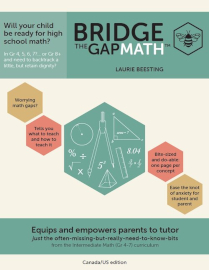Bridge the Gap Math™ is a resource book for identifying and teaching individual math topics that might have been missed or not mastered in the curriculum for grades five through seven. Rather than a complete curriculum for any one grade level, it is a compilation of brief lessons and tips on key topics taught across several grade levels. It can be used with a bright fourth grader who wants to jump ahead, but it’s most useful for identifying and filling gaps so middle school students are prepared for prealgebra.
Bridge the Gap Math was developed by Laurie Beesting, who taught in British and Canadian schools and privately tutored for more than 30 years. I reviewed the Canada/US edition of the book. The coverage of math in school systems of the U.S., Canada, and Britain is so similar that Bridge the Gap Math works fine for U.S. students.
There are two components—a diagnostic tool (assessment) and a book. You do not need the diagnostic tool, but it should save time if you want to use Bridge the Gap Math with a student at the end of sixth grade or above since it tests for concepts taught in sixth and seventh grade. Students struggling with math in high school might also be able to identify gaps in their background knowledge that need to be remediated.
The Book
Bridge the Gap Math is a 257-page softcover book, divided into four unitsas follows:
- Number
- Fractions, Decimals and Percentages
- Shape and Geometry
- Times Tables, Exponents and Prime Numbers
As you can see by the topics, they don’t progress in the same order as in school, but the organization is very logical. For example, reviewing times tables in the same unit with exponents and prime numbers makes sense because mastery of the times tables is essential for being able to identify prime numbers, find square roots, and evaluate numbers with exponents.
Students need paper, a pencil, a ruler, and a protractor, but they are not to use a calculator. They will write in the book, although they might also work or draw on separate paper. The book is not reproducible, so separate copies are needed for any additional students.
The book can be used in several ways as explained in “Guidance for Use and Getting Started” on page 11, but the process for each lesson remains the same. A parent or teacher will work through four steps with the student. In Step 1, the learning objective is identified clearly. In Step 2, you read through and discuss the explanation. Step 3 provides eight practice questions, and the student also makes up two similar questions for the parent/teacher to answer. The process of creating questions demonstrates an understanding of concepts. In Step 4, students answer eight “test” questions without guidance or examples. Students can answer orally or on paper. Answers to questions in Step 3 and Step 4 are to the far right of each problem and need to be hidden if students are working in or viewing the book, which will likely be the case most of the time.
Checklists at the beginning of each unit help keep track of a student’s status on each concept.
The section on times tables differs from the other lessons and might require more time and practice than others if this is a weak area. Students can warm up for a lesson on any topic with a times-table-related activity, such as skip counting practice or one of the many creative ideas suggested on page 209.
The final chapter of the fourth unit is “Flash Facts,” ten pages with what looks like more than 200 problems based on all four units. These can be used for warm-ups, review, or just for fun. Using just a few of them at a time—like a quick game with some sort of reward—might be a great way to motivate students. The questions are to be presented orally, although students can use paper and pencil if needed, for instance, to draw a rectangle and divide it into thirds and sixths. Answers follow immediately after each question.
The Diagnostic Tool
The Diagnostic tool is a downloadable PDF assessment with 25 questions that can be administered by parents or teachers. Instructions for administration and the answer key are included. It is not timed, and students should try to answer all the questions. However, students need to understand that it’s a diagnostic tool and is not graded like a course test.
Under each question, a code (U1, U2, U3, or U4) identifies which of the book’s four units cover the concept, so you know which section of the book to use for remediation on missed questions. (It would be even more helpful if it identified the pertinent pages within each unit.)
Questions begin with advanced multiplication and division and continue with fractions, decimals, percents, measurements (metric system), averages, geometry, prime and composite numbers, roots, and exponents. With only 25 questions in all, there are only one or two questions on each concept.
I was able to use the diagnostic test with a rising eighth grader who lags behind in math, and it was perfect for identifying weak areas. There were enough problems to identify weak areas without overwhelming her with a lengthy assessment.
Summary
Bridge the Gap Math should be extremely helpful for the many homeschooled students who need to ensure that math skills are up to par..









